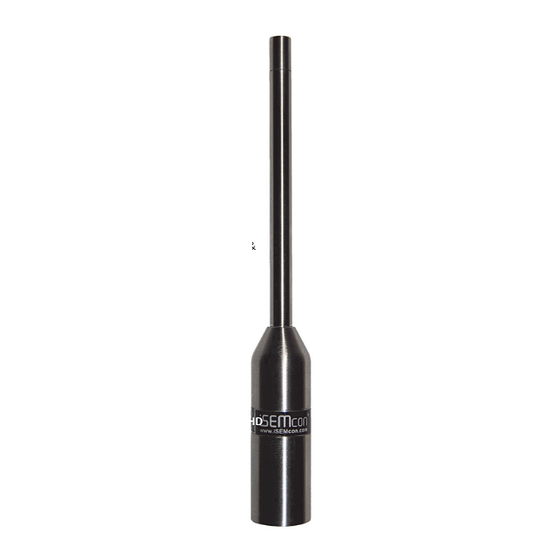
Summary of Contents for iSEMcon EMX-7150
- Page 1 PRODUCT INFORMATION EMX-7150 single use microphone, matched pairs, triples, quads 01-17...
- Page 2 AT A GLANCE The EMX-7150 is a ¼” microphone made from stainless steel and using state of the art water tight Neutrik*3 connectors hav- ing a very accurate frequency response...
- Page 3 measure high sound pressure levels up to 145dBspl. It is a low impedance measurement microphone that can be operated from 12…52 V Phantom Power which is available on most professional micro- phone preamplifiers and professional computer interfaces. With its mechani- cally robust design it is well suited for harsh environment use such as open air sound reinforcement measure-...
-
Page 4: Specifications
SPECIFICATIONS Values for 23° Celsius and 48V Phantom Power... -
Page 5: Frequency Response
FREQUENCY RESPONSE ISOBARS, typical... - Page 6 POLAR PATTERNS, typical...
- Page 7 THD vs SPL, typical k2, k3 and THD (blue/red/green) THD vs SPL, typical Equivalent Noise: FFT, 1/3 Octave, A- weighted, ITU-R 468 RMS weighted (magenta, blue, green, red)
- Page 10 @ 1kHz. The diagram on previous page shows how tempera- ture affects the frequency response behavior of an EMX-7150 microphone. The microphone capsule itself is the part being responsible for most of the temperature change. (see also: Tem- perature characteristics of electret con- denser microphones Acoust.
- Page 11 The matching tolerance is applicable within the microphone’s entire frequency range. For the EMX-7150 the matching toler- ance on frequency response is +/- 0.5dB and 1mV on microphone sensi- tivity. The matching process (1-4): The first stage of testing begins with the selection of microphone capsules.
- Page 13 and 48V Phantom power. Finally we are selecting one reference microphone (A) and compare the over- all frequency responses of its potential partners. FOH: You measure and optimize the acoustical sound field for the audience together with SPL or better say Leq monitoring…..
- Page 14 Reference Speaker Measurement using Reference microphone MLS Signal (Maximum Length Sequen- ce) + Gating (No room response / re- flections) Replacing Reference mic with EMX- 7150 microphone Calculating EMX-7150 frequency res- ponse from impulse response data...
- Page 15 P r e s s u r e C h a m b e r M e t h o d 10Hz...500Hz Direct compare of EMX-7150 against a Lab Standard Refernce Microphone using sine sweep signal *1 *1 Freefield microphones as well as pres-...
-
Page 16: Application Notes
APPLICATION NOTES FREEFIELD vs. DIFFUSEFIELD USE Only a small percentage of all acousti- cal measurements are performed in a well defined and/or well controlled environment of an e.g. acoustical labo- ratory – on the contrary most acousti- cal measurements are done under not really controlled conditions. - Page 17 A microphone’s random (diffuse) inci- dence response can be approximated by measuring the 90º incidence response relative to a single sound source (as per B&K literature). The diffuse field response is not easy to measure, because it is not easy to gener- ate a truly diffuse sound field over a wide frequency range but there is a known procedure to estimate the diffuse fre-...
- Page 18 While it is an approximation only iSEM- con has measured the 90deg response of many EMX-7150 microphones and used the averaged data to evaluate a order polynomial. This is now used to derive the “diffuse field” response from the microphones free field re- sponse data.
-
Page 19: Maintenance
In an unlikely event of equipment failure, please contact your local iSEMcon repre- sentative or the iSEMcon factory located Germany (sales@iSEMcon.com). Unauthorised dismantling of the mic- rophone will invalidate the warranty. -
Page 20: Ordering Information
ORDERING INFORMATION... -
Page 21: Limited Warranty
Without this proof, which will be checked by iSEMcon, no claims may be put forward. iSEMcon and its partners reserve the right to charge a process-... - Page 22 OR VERBAL, BEYOND THIS PRINTED VERSION. ALL IMPLIED WARRANTIES ARE ONLY VALID FOR THE DURATION OF THIS LIMITED WAR- RANTY. ISEMCON IS, TO THE EXTENT THAT AN EXCLUSION OF LIABILITY IS PERMITTED, IN NO INSTANCE LIABLE FOR INDIRECT OR CONSE-...
- Page 23 product.
- Page 24 LLC iSEMcon GmbH 8530 Sylvania-Metamora Rd. Zeppelinstr. 6 Sylvania, OH 43560 68519 Viernheim Germany Fon 1-877-309-1002 Fon +49 6204 911 24 91 Fax +49 6204 911 24 90 sales@iSEMcon.com www.iSEMcon.com...


Need help?
Do you have a question about the EMX-7150 and is the answer not in the manual?
Questions and answers